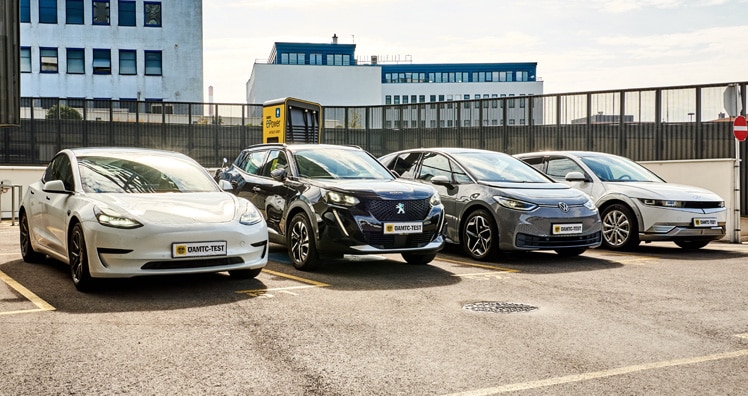| Tobias Seyfried
| 09/04/2022
Due to the unsatisfactory test results, ÖAMTC is demanding more efficiency from manufacturers – drivers have to pay for electricity they cannot use.
Although the development of electric mobility continues, it has already made great progress in recent years. Charging technologies are getting better, the energy density of battery cells is getting higher and so the ranges are increasing as well – and when it comes to energy efficiency while driving, no other type of engine can beat the electric motor by as much as 94 percent (gasoline engine: almost 40 percent).
However, according to Markus Kaiser, e-mobility expert at ÖAMTC, there is room for improvement: “For example, many e-car drivers don’t realize that the electricity they charge – and pay for – doesn’t actually end up in the drive battery.” So the Mobility Club examined the charging characteristics of four popular models: Hyundai Ioniq 5, Peugeot e-2008, Tesla Model 3 and VW ID.3.
© ÖAMTC
Bandwidth of download losses is unusually high
Before we get into the results, we must make it clear that this is not possible without losses due to purely technical reasons. However, according to Kaiser, the range of cargo losses is unusually high. “For example, with regular alternating current (AC) charging, depending on the vehicle, approximately seven to about ten percent of the assumed charged power should be written off as a loss,” summarizes the expert. Especially in times of rising prices and increased efforts to save energy, it is essential that these losses be contained as far as technically possible.
“We see clear differences in the efficiency of the components installed here. There is still a lot of improvement potential, especially in converting grid-side AC to battery-side DC,” explains the ÖAMTC expert. Therefore, vehicle manufacturers and charging stations are being asked to increase the efficiency of chargers. That would be positive in terms of optimum use of resources, but not least for the motorist’s electronic wallet: inside.
Load losses up to 10 percent
Regardless of charging (AC or DC), most losses always occur when AC power from the grid is converted to DC power from the battery. If the entire series of line losses are taken into account in the cables, the losses during conversion to direct current and the charge losses that occur directly in the car engine battery, the bottom line in the ÖAMTC test is that charge losses when charging with alternating current are about 10 percent.
AC charging tests showed significant differences in the efficiency of the chargers installed on board the tested vehicles. The best of all was Tesla, ahead of Volkswagen, Hyundai Ioniq 5 and Peugeot. With the Model 3 and OBC, which is very efficient for AC charging, there were only 6.69 percent charge losses. In the other three test vehicles, charge losses with AC charging were much higher, which explained the dramatic differences in efficiency in rectifying current in the vehicle.
© ÖAMTC
To determine the DC charge losses for all the four test vehicles, only losses in the vehicle were considered on the one hand, and on the other hand, the total losses that occur both in the vehicle and at the charging station when switching electricity are considered. The Ioniq 5 with its state-of-the-art 800V technology emerged as the efficiency winner right before the Model 3. Both vehicles caused total charging losses of less than 0.5 percent on the side of the vehicle or about six percent in the case of conversion losses at the charging station.
© ÖAMTC

“Total coffee aficionado. Travel buff. Music ninja. Bacon nerd. Beeraholic.”









More Stories
Wolfsburg instead of Wörthersee: The first GTI meeting starts at Volkswagen headquarters
Pecco Bagnaia (Ducati): Testing on the new Panigale/MotoGP
From autumn onwards, U2 will be playing again at Karlsplatz.